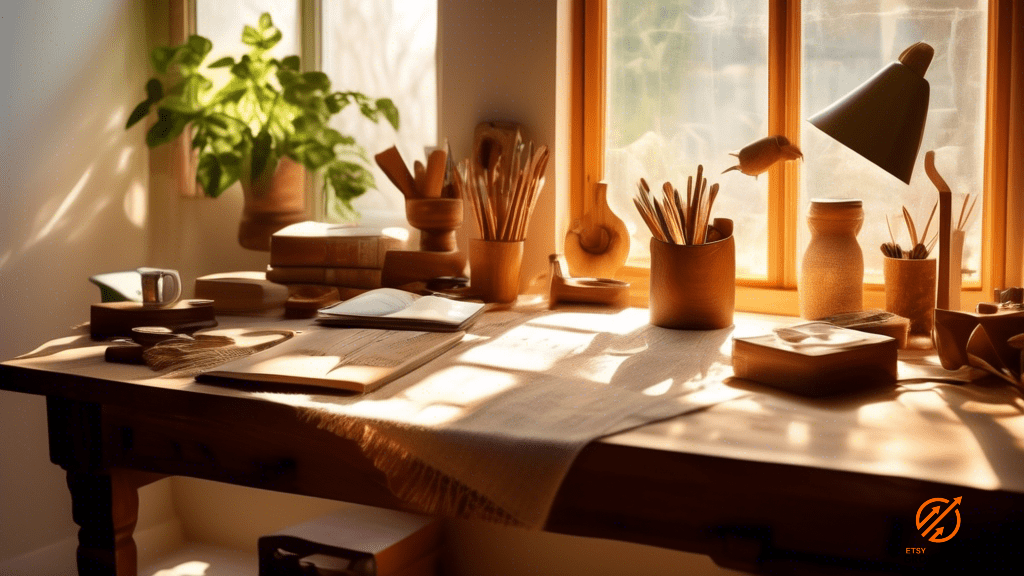Are you struggling to determine the right price for your handmade items? Pricing your products can be a challenging task, but it is crucial for the success of your business.
In this guide, we will walk you through the process of pricing your handmade items so that you can ensure profitability while still remaining competitive in the market.
Understanding the value of your handmade items is the first step in determining their price. It is important to consider the time, effort, and skill that goes into creating each piece. Additionally, you should take into account the cost of materials, packaging, and any other expenses associated with producing your items.
By calculating these costs and expenses, you can establish a baseline for your pricing strategy. In the next section, we will delve deeper into the process of calculating costs and expenses for your handmade items.
Understanding the Value of Your Handmade Items
Do you ever wonder how much your handmade items are truly worth? Pricing your handmade items can be a tricky task, but understanding their value is essential.
It’s important to consider the time, effort, and skill that goes into creating each piece. Think about the materials you use and the cost associated with them. Additionally, take into account any unique or special features that set your handmade items apart from others on the market. These factors all contribute to the value of your creations and should be considered when determining the price.
Another aspect to consider when understanding the value of your handmade items is the market demand. Research the market and see what similar items are selling for. Take note of their quality, craftsmanship, and pricing. This will give you a better understanding of where your handmade items fit in and what customers are willing to pay.
Remember that pricing too low may devalue your work, while pricing too high may discourage potential buyers. Finding the right balance is key. By understanding the value of your handmade items, you can confidently price them and ensure that you are properly compensated for your time and talent.
Calculating Costs and Expenses
Calculating costs and expenses can be a complex task, but breaking it down into smaller components can help you visualize the different factors involved.
The first step is to determine the cost of materials. This includes the price of the raw materials you use to create your handmade items, as well as any packaging materials or labels that are necessary.
Next, you’ll need to consider the cost of labor. This includes the time it takes you to create each item, as well as any additional costs associated with production, such as equipment or workspace rental. It’s important to calculate your labor costs accurately, as this is a significant factor in determining the overall price of your handmade items.
In addition to materials and labor, you’ll also need to factor in any overhead expenses. This includes costs such as utilities, insurance, and marketing expenses. These costs may not be directly related to the creation of each individual item, but they are still necessary for running your handmade business.
By breaking down the costs and expenses of creating your handmade items, you can get a better understanding of the overall value and price that should be set. It’s important to consider all of these factors when determining the price of your handmade items, as it ensures that you are properly compensated for your time and effort.
Researching Market Trends and Competitor Pricing
When researching market trends and competitor pricing, you’ll want to gather information from various sources to ensure you have a well-rounded understanding of the market. Start by looking at similar products in your niche and analyzing their pricing strategies. Check out online marketplaces, such as Etsy or Amazon, and take note of the prices for handmade items similar to yours. Additionally, visit local craft fairs or boutiques to see how other artisans are pricing their products.
Another valuable source of information is social media platforms. Look for relevant hashtags or groups where makers and sellers in your industry share their products and prices. Engage with these communities and ask questions to gain insights into pricing trends. It’s important to gather as much data as possible to establish a benchmark for your own pricing strategy.
To help organize your findings, consider creating a table like the one below:
| Competitor | Product | Price |
|---|---|---|
| Shop A | Handbag | $50 |
| Shop B | Necklace | $25 |
| Shop C | Scarf | $30 |
In this table, list your competitors’ names, the product they offer, and the corresponding price. This allows you to compare and analyze the pricing range within your market. Keep in mind that pricing should not solely be based on what your competitors are charging. It’s important to consider your own costs, expenses, and unique selling points when determining your final pricing strategy.
Pricing Strategies for Profitability
To ensure profitability, you need to be as strategic with your pricing as a skilled chess player making their moves.
The right pricing strategy can make all the difference in the success of your handmade business. Here are some strategies to consider:
- Cost-plus pricing: This strategy involves calculating the cost of materials, labor, and overhead, and then adding a markup to determine the selling price. It ensures that you cover your costs and make a profit.
- Value-based pricing: This strategy is based on the perceived value of your handmade items. It involves setting the price based on what customers are willing to pay for the unique qualities and craftsmanship of your products.
- Competitive pricing: This strategy involves pricing your items in line with your competitors. It requires researching and analyzing the prices of similar products in the market and adjusting your prices accordingly.
- Premium pricing: This strategy involves setting higher prices for your handmade items to position them as luxury or high-end products. It relies on creating a perception of exclusivity and quality to attract customers willing to pay a premium.
By carefully considering these pricing strategies and finding the right balance, you can maximize your profitability and ensure the success of your handmade business.
Communicating Value to Customers
Show customers why your handmade products are worth the price by highlighting the unique craftsmanship and attention to detail. When communicating the value of your items, it’s important to emphasize the time, effort, and skill that goes into creating each piece.
Let customers know that your products are not mass-produced, but rather made with love and care by hand. Highlight any special techniques or materials that you use, and explain how these add to the quality and durability of the item. By showcasing the craftsmanship and attention to detail, you can help customers understand why your handmade products are worth the price you’re asking for.
In addition to highlighting the craftsmanship, it’s also important to communicate the story behind your handmade items. Share your inspiration, the process of creating the item, and any personal touches that make it unique. Customers appreciate knowing the story behind the product they’re purchasing, and it adds to the overall value and experience of owning a handmade item.
You can also offer personalized options or customization to further enhance the value for your customers. By clearly communicating the value and uniqueness of your handmade products, you can build trust with your customers and justify the price you’re charging.
Frequently Asked Questions
How can I determine the perceived value of my handmade items in the market?
To determine the perceived value of your handmade items, consider factors like the quality, uniqueness, and craftsmanship. Research similar products in the market, gather feedback from potential customers, and adjust your pricing accordingly to ensure a competitive yet profitable price.
What are some effective strategies to adjust my pricing based on changing market trends?
You can effectively adjust your pricing based on changing market trends by staying informed and responsive. Keep an eye on what competitors are charging, analyze customer feedback, and adapt your prices accordingly to meet demand and maximize profit.
Is it necessary to consider competitor pricing when setting the price for my handmade items?
Yes, it is necessary to consider competitor pricing when setting the price for your handmade items. By understanding what your competitors are charging, you can ensure that your prices are competitive and appealing to customers.
How can I effectively communicate the value of my handmade items to customers without appearing pushy?
To effectively communicate the value of your handmade items without appearing pushy, focus on highlighting the unique features, craftsmanship, and attention to detail. Share the story behind your creations, offer personalized customer service, and use compelling visual content to showcase their beauty.
Are there any legal considerations or regulations I should be aware of when pricing my handmade items?
When pricing your handmade items, it’s crucial to consider legal considerations and regulations. By understanding and adhering to these rules, you can ensure your pricing is fair and compliant, giving customers peace of mind and boosting your credibility.
Last Updated: January 22, 2024
Disclosure: We may receive affiliate compensation for some of the links in this article at no additional cost to you if you decide to purchase a product. You can read our affiliate disclosure in our privacy policy.
Kevin Fairbanks is your expert navigator in the world of Etsy business. With a passion for creativity and a deep understanding of the e-commerce landscape, Kevin brings a wealth of knowledge to aspiring and established Etsy sellers alike.
As a seasoned entrepreneur and successful owner of multiple Etsy shops, Kevin knows firsthand the challenges and triumphs of the Etsy marketplace. His journey is one of innovation, perseverance, and a keen eye for market trends, making him an invaluable guide for anyone looking to succeed on Etsy.
Kevin’s expertise extends beyond just shop management; he is adept in areas such as SEO optimization, effective marketing strategies, and financial planning for online businesses. His insights are grounded in real-world experience, offering practical and actionable advice.
Join Kevin as he shares his journey and expertise on Etsy Growth Hub. Whether you’re starting your first Etsy shop or looking to expand your existing business, Kevin’s guidance is designed to help you navigate the complexities of Etsy selling with confidence and creativity.
Stay tuned with Kevin’s latest strategies and tips on Etsy Growth Hub to transform your passion into a thriving online business. His dedication to empowering Etsy sellers is evident in every piece of advice he shares, helping you turn your Etsy dreams into reality.
Verified and Approved by:

Kevin Fairbanks
Head of SEO
Like This Article?
Share with your friends
Table of Contents
Latest Articles
Keep Reading
-
Generating Positive Product Reviews
Unlock the Secrets to Generating Positive Product Reviews and Boost Your Sales! Learn how to harness the power of customer feedback today and watch your business thrive. Click here for expert tips and tricks!
-
Running Successful Twitter Campaigns For Your Etsy Shop
Boost sales and visibility for your Etsy shop with expert tips on running successful Twitter campaigns. Learn how to dominate the online marketplace with effective strategies. Click now and start boosting your Etsy sales!
-
How To Price Your Handmade Products Considering Your Time And Skill
Want to maximize your profits for your handmade products? Learn the secret to pricing your time and skill effectively! Click now to discover how to value your work and boost your earnings.




